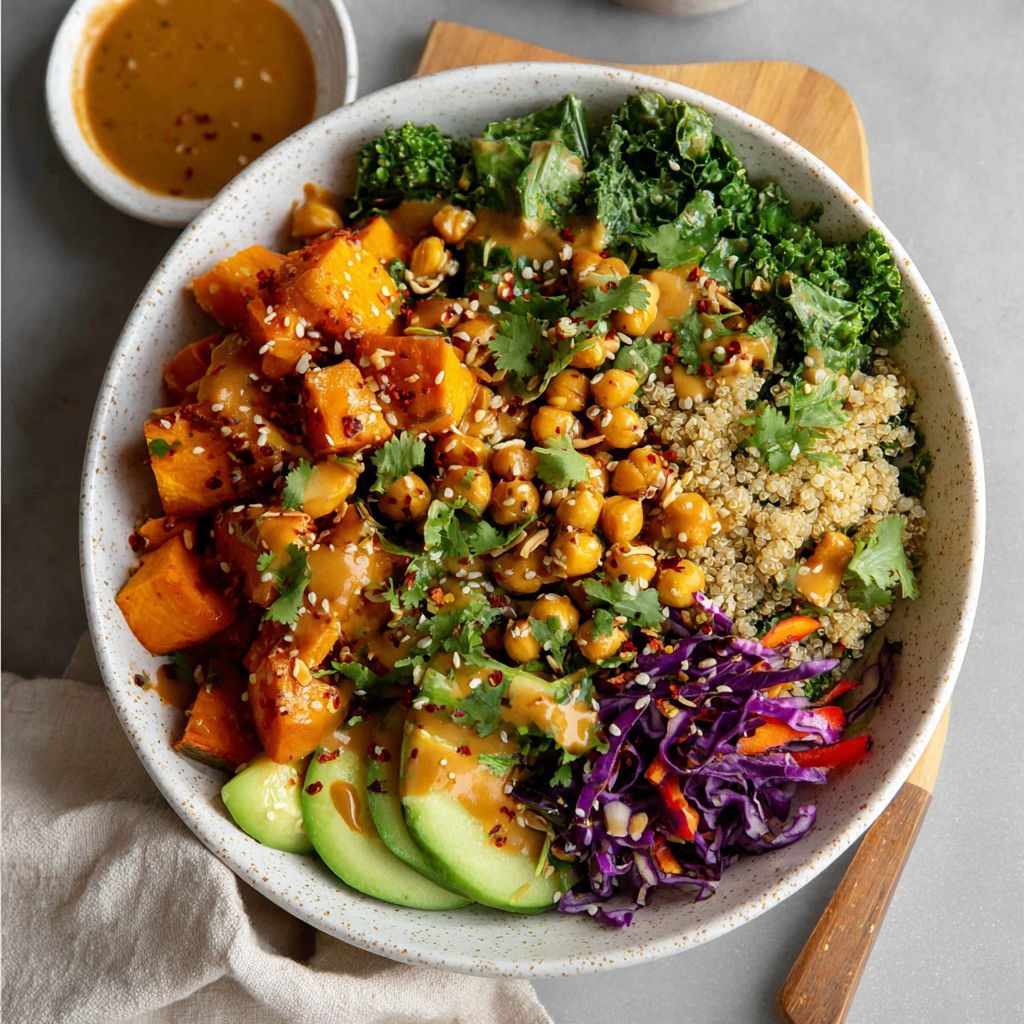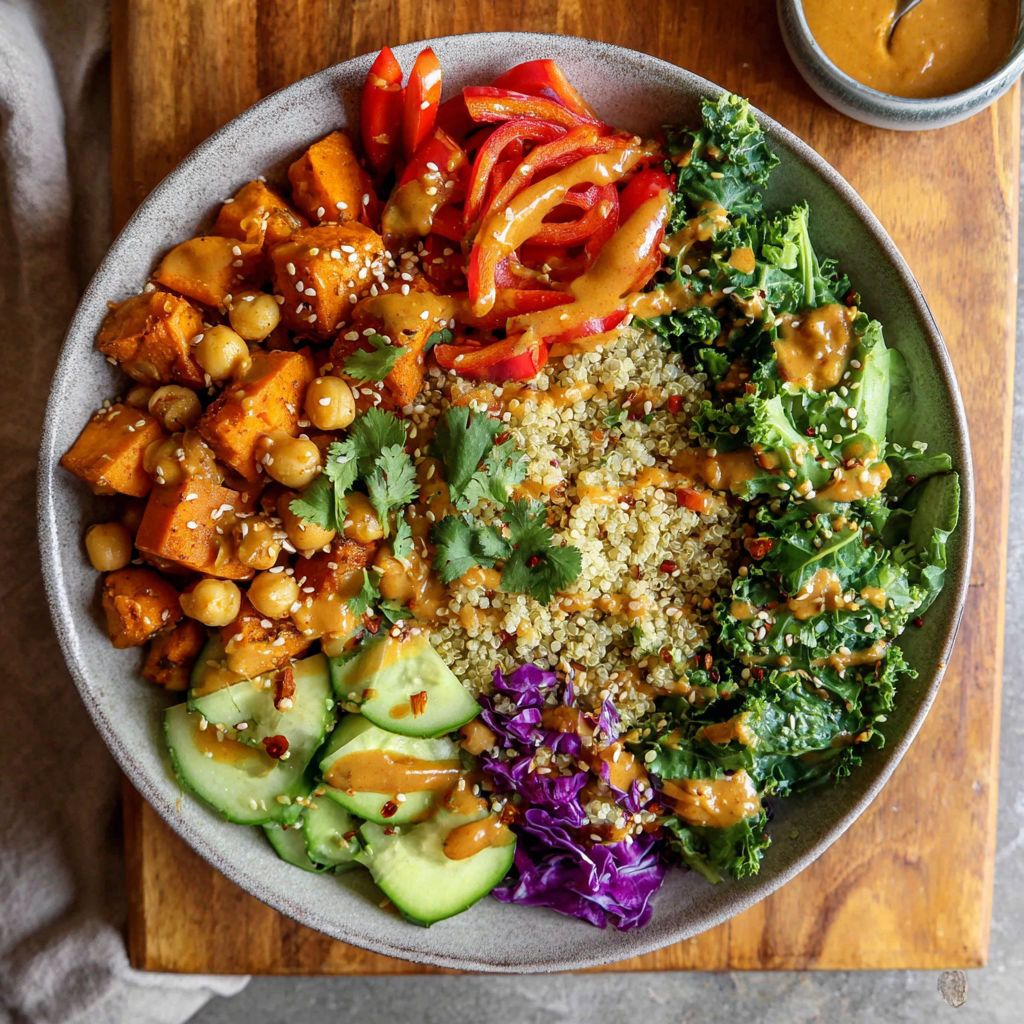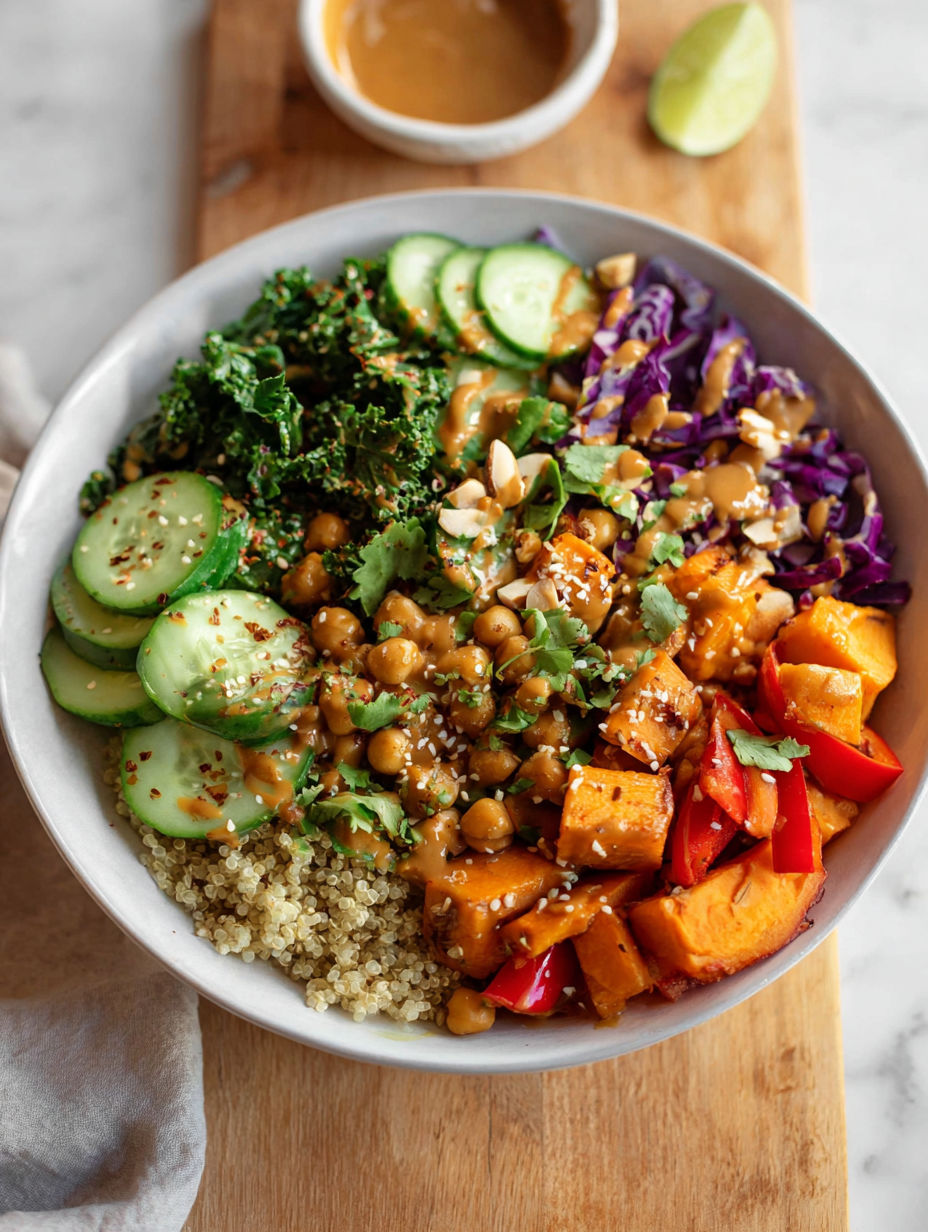 Pin
Pin
This vibrant Thai Peanut Sweet Potato Buddha Bowl combines nourishing roasted sweet potatoes, protein-packed quinoa, and crisp vegetables all drizzled with a creamy peanut sauce that brings everything together in perfect harmony. Each colorful component adds not just visual appeal but layers of texture and nutrition in every bite.
I first created this recipe when transitioning to more plant-focused meals and it quickly became my go-to lunch option. My skeptical husband who usually passes on vegetarian dishes now requests this buddha bowl regularly which feels like the ultimate culinary victory.
Ingredients
- Sweet potatoes: bring natural sweetness and hearty texture while providing vitamin A and fiber
- Quinoa: offers complete protein and a fluffy base that absorbs the sauce beautifully
- Chickpeas: add protein and satisfying chew that makes this bowl truly filling
- Mixed greens: provide a fresh nutrient-rich foundation
- Red bell pepper: delivers sweet crunch and vibrant color plus vitamin C
- Purple cabbage: adds gorgeous color crisp texture and cancer fighting compounds
- Cucumber: offers refreshing crunch and hydration to balance the richer elements
- Cilantro: brings bright herbal notes that complement the Thai flavors perfectly
- Peanuts: provide essential crunch and protein while enhancing the peanut sauce
- Peanut butter: forms the creamy base of our sauce with healthy fats and protein
- Soy sauce: delivers umami depth and saltiness to balance the sweetness
- Lime juice: adds essential acidity that brightens the entire dish
- Maple syrup: balances the savory elements with just enough sweetness
- Fresh ginger and garlic: create aromatic complexity that makes the sauce irresistible
How To Make Thai Peanut Sweet Potato Buddha Bowl
- Roast the sweet potatoes:
- Toss cubed sweet potatoes with olive oil salt and pepper making sure each piece is evenly coated. Spread them in a single layer on a baking sheet giving them plenty of space so they roast rather than steam. Roast at 400°F for 25-30 minutes until edges are caramelized and centers are tender.
- Cook the quinoa:
- Rinse quinoa thoroughly under cold water to remove any bitterness. Combine with water in a 1 to 2 ratio in a saucepan and bring to a boil. Reduce heat cover and simmer for 15 minutes until water is absorbed and quinoa has sprouted its little tails. Let stand covered for 5 minutes then fluff with a fork.
- Prepare the peanut sauce:
- Whisk peanut butter soy sauce lime juice maple syrup minced garlic and grated ginger in a bowl until completely smooth. Add water tablespoon by tablespoon until you reach a pourable but thick consistency. Taste and adjust seasonings adding more lime for acidity or maple syrup for sweetness.
- Warm the chickpeas:
- Heat a small skillet over medium heat with a touch of oil. Add drained and rinsed chickpeas along with a pinch of salt and any desired spices like cumin or paprika. Warm for 3-5 minutes until heated through and slightly crispy on the outside.
- Assemble your bowls:
- Start with a generous base of mixed greens in each bowl. Arrange sections of roasted sweet potatoes quinoa and warm chickpeas around the bowl. Add vibrant red bell pepper slices shredded purple cabbage and cucumber creating a colorful arrangement.
- Finish and serve:
- Drizzle the Thai peanut sauce generously over each bowl. Sprinkle with chopped cilantro and peanuts for freshness and crunch. Serve immediately or refrigerate components separately for meal prep.
The peanut sauce is truly the star of this recipe and I've spent years perfecting it. My grandmother who lived in Thailand for several years once tasted it and declared it reminded her of the street food she enjoyed in Bangkok. That moment of culinary connection across generations made this recipe even more special to me.
Make Ahead & Storage Tips
These buddha bowls make exceptional meal prep as the components can be prepared up to 3 days in advance. Store each element separately in airtight containers in the refrigerator. Keep the sauce in a small jar and the chopped peanuts and cilantro in their own containers. When ready to eat simply assemble your bowl and dress it with the sauce and toppings. The sweet potatoes and quinoa can be reheated if desired but taste wonderful at room temperature as well.
Ingredient Substitutions
This recipe welcomes adaptation based on what you have available. Swap sweet potatoes for butternut squash or regular potatoes. Replace quinoa with brown rice farro or cauliflower rice for a lower carb option. No chickpeas? Try edamame black beans or even tofu. The sauce works beautifully with almond butter or sunbutter for those with peanut allergies just adjust the sweetness as needed. For a lower sodium version use coconut aminos instead of soy sauce. Fresh vegetables can be swapped based on seasonal availability just aim for a variety of colors and textures.

Serving Suggestions
While this buddha bowl is a complete meal on its own I love serving it with a few enhancements that take it to the next level. A side of coconut lime rice makes an excellent complement especially when feeding hungrier guests. For added protein grilled chicken or shrimp work beautifully alongside or on top of this bowl. During summer months I often add sliced mango or pineapple for tropical sweetness. For gatherings set up a buddha bowl bar with all components separated allowing guests to build their own personalized bowls. A small ramekin of sriracha on the side lets each person adjust the heat level to their preference.

Recipe FAQs
- → Can I make this Thai Peanut Buddha Bowl ahead of time?
Yes! This Buddha bowl is perfect for meal prep. Roast the sweet potatoes, cook the quinoa, and prepare the sauce up to 3 days in advance. Store components separately and assemble just before eating. For best results, keep the sauce separate until serving time.
- → Is this Buddha bowl vegan?
The bowl is vegan if you use maple syrup instead of honey in the peanut sauce. All other ingredients are plant-based, making this a protein-rich vegan meal option.
- → How can I add more protein to this bowl?
While the quinoa and chickpeas already provide good protein, you can add tofu, tempeh, grilled chicken, or salmon for extra protein. Simply season and cook your protein of choice and add it alongside the other components.
- → Can I customize the vegetables in this Buddha bowl?
Absolutely! The beauty of Buddha bowls is their flexibility. Feel free to substitute with seasonal vegetables or whatever you have on hand. Edamame, avocado, carrots, broccoli, or snap peas would all work wonderfully in this bowl.
- → How spicy is the Thai peanut sauce?
The basic sauce recipe is mild, but you can adjust the heat level by adding the optional red chili flakes. Start with 1/2 teaspoon and increase to taste. For extra heat, you could also add a bit of sriracha or sambal oelek.
- → Is this Buddha bowl gluten-free?
The bowl can be made gluten-free by using tamari instead of soy sauce in the peanut dressing. Always check your other packaged ingredients to ensure they're certified gluten-free if needed.
